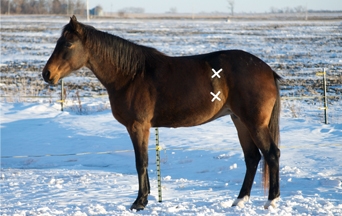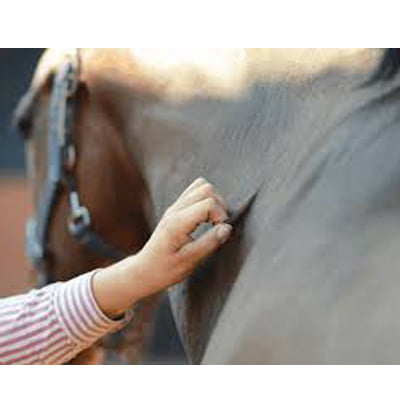How To Check The Vital Signs On Your Horse. Do you know how? Temperature, Pulse, Respiration, Gut Sounds, Capillary Refill Time & The Pinch Test.
Whether it’s the Fall Transition, Winter, Spring or Summer, it’s always a good time to talk about keeping a close eye on our Equine family by knowing what to look for in our horse’s Vital Signs.
If your horse is having problems and you make a call to your Vet some of his/her first questions may involve your horse’s vital signs. It is a good thing to practice before an emergency presents itself so that you are calmly able to give the Vet the info they need and also to have a baseline of what is the “normal” for your horse.

How To Check The Vital Signs On Your Horse
Temperature
The normal range for a horse is 99.5 to 101.5. Stand on one side or the other of the horse’s hindquarters. Plastic digital thermometers register a temp pretty quickly.
It is a good idea to tie a string to the end of the thermometer. If the temp is higher than 102.5 contact your Veterinarian.
Pulse
Normal Range 30-42 beats per minute.
Chest wall if you own a stethoscope, position yourself on the left side of the horse, at the front shoulder, facing to the rear of the animal. Locate the elbow of the horse and place the diaphragm just behind the elbow on the chest wall. Press moderately and listing for a low dub-dub sound. When you can clearly hear the sound, count each dub-dub for 15 seconds, then multiply by 4 for the bpm.
Maxillary Artery:
Stand slightly to the side of the horse’s head and cup your hand with your first two fingers along the inside of the jawbone, just below the heavy muscles of the cheek. Feel along the inside of the jawbone until you consistently feel the pulse beat. Looking at your watch, count the beats for 15 seconds, then multiply by 4 to give you bpm.


Digital Artery:
Crouch facing the limb and locate the digital artery with the pads of your fingers. The pulse may be best found on the inside or outside branch of the digital artery. On this horse, the pulse was more easily felt on the outside branch. Place the pads of your fingers on the artery and the beats for 30 seconds, then double for bpm.
Respiration
Normal range 12 to 20 breaths per minute. To calculate a horse’s respiration rate, simply watch his chest. One inhalation-exhulation counts as one breath.
Gut Sounds
You can either use a stethoscope or just place your ear next to the horse’s side to listen to gut sounds.
There are generally four locations in which to listen to gut sounds. They are located in the upper and lower flank area on each side of the horse. This is the ‘hind gut’, where digestion of food primarily takes place.
Here’s what you’ll be listening to specifically in each of the quadrants:

Upper left quadrant: small intestine
Lower left quadrant: large intestine
Upper right quadrant: large intestine and cecum (the cecum is a common site for impaction colic.)
Lower right quadrant: large intestine
The small intestine tends to be fairly quiet while the large intestine and cecum tend to be a source of more sounds.
Types of Gut Sounds
There are a variety of types of sounds you might hear when listening to the gut. Normal gut sounds will likely sound like a mixture of grumbles, roars, and even tinkling sounds. There is no specific rhythm, but you should hear a sound every few seconds or so.
When dehydration occurs there will be a decrease in the frequency and intensity of gut sounds.
Silence could indicate several things–gas, impending diarrhea, or impaction. Again, if you listen to all four quadrants and don’t hear anything, a call to your vet is advised!
Faint tinkling sounds could indicate ulcers or possibly an infection, but this is something that a vet would need to diagnose. A constant rumbling likely indicates diarrhea.
If the horse is showing other signs of distress such as not eating, lethargy, rolling, pawing, etc…. Call your Vet immediately, then check for gut sounds.
Capillary Refill Time
Normal: 2 seconds
Press on your horse’s gums above his teeth and see how long it takes for the color to return. Longer capillary refill time may indicate circulatory problems. The color of the gums is important. Pink is healthy, red, pale or purplish gums ay mean there is a problem.
Pinch Test
Pinch a fold of skin on your horse’s neck and release it. It should immediately drop back into place. If it remains “pinched”, that’s a sign of dehydration. Keep electrolytes on hand for emergencies!!!
Kathy Hartwig
Equine Challenge Supplements


